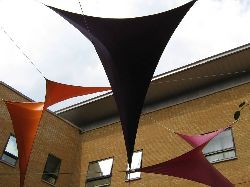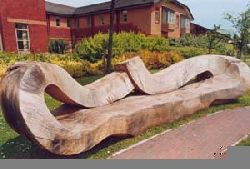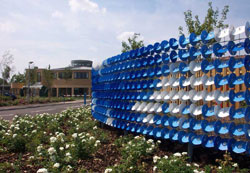Patient Environments and the Arts
Conference Report
The Patient Environments and the Arts conference was organised by Wilmington Conferences with media partners Hospital Development magazine, hes (Healthcare Equipment and Supplies magazine) and MLW (Medical Laboratory World) and was held at the Royal College of Physicians, Regents Park, London on 22 January 2007.
The conference was attended by 65 delegates from a broad variety of backgrounds including hospital arts managers, clinicians, facilities and capital project managers, artists, architects, journalists and researchers.
Sunand Prasad: Keynote address
The keynote address was given by Sunand Prasad, a partner with Penoyre & Prasad and President-Elect of the Royal Institute of British Architects. In the address, Mr Prasad focused on the role of architecture to communicate with its users through visual appearance. In a healthcare environment, neglect of the surroundings – a lack of “houseproud-ness” can constitute neglect of the patient and the patient’s surroundings are also the conditions the staff work in. Pride in our surroundings should be in our bloodstream and patients should be ‘guests’ in hospital; currently this is not the case and even modern hospitals can be spoilt by clutter and visual accretions. Mr Prasad showed some examples from hospitals where he has visited relatives.
There was audience discussion of the best way to avoid clutter, given the pressure on hospital staff to promote services, healthy lifestyles etc and lack of display space in many hospitals. It was felt that a tidy and well-presented hospital required a whole-hospital policy with strong senior leadership, staff ownership of the policy and policing. Another theme mentioned was that the separation between artists and architects is of relatively recent origin; in former times it was usual for them to work together from the start. To this end, Penoyre & Prasad have been working with artist Alison Turnbull on the ‘bird in flight’ façade design for Moorfields Eye Hospital in London.
Susan Francis: Architectural Advisor, NHS Confederation: ‘Designing for the new healthcare landscape’
Susan Francis spoke about the changing patient/consumer expectations of healthcare and an increasing demand for choice, personalized services, control and convenience. This is combined with increasing diversity of healthcare providers and a desire for care closer to home. She also mentioned the Achieving Excellence in Design Toolkit, AEDET.
What values should/do healthcare environments communicate? Healthcare buildings should give a sense of arrival and should differentiate public, private and social space. What are the key differences between these spaces, and how can the architecture, design and artwork reflect or signal them? Later, she defined ideal values for these spaces as Public: Obvious but not institutional; Private: Convenient but not impersonal and Social: Efficient but not intimidating. She talked of ‘dignity of interaction’, which is supported by facilities such as pleasant, well-designed dayrooms. She gave the example of BECAD and ACAD in Middlesex as well designed environments for care. Buildings should help people to navigate around them; signage, while important, should be the last resort.
Susan Francis showed examples of well-designed healthcare environments arranged under the themes: ‘First Impressions’, ‘Welcoming’, ‘Sense of Arrival’, ‘Reception’, ‘Intuitive Wayfinding’, ‘Showing the Route’, ‘Placemaking’, ‘Directions’, ‘Dignity of Interaction’, ‘Waiting in Comfort’, ‘Stimulating and Fun’, ‘Intimate’, ‘Privacy of Place’, ‘Treatment Rooms’, ‘Medical Landscapes’, ‘Personal Space’, ‘Stimulate the Senses’, ‘Colour and Light’, ‘Touch See Hear Smell’, ‘Lightbox’, ‘Performance’, ‘Interactive Media and Film’, ‘Local Materials’, ‘Inside Out’, ‘Therapeutic Gardens’, ‘Rooms with a View’, ‘Celebrating Local Skills’ and ‘Secure Spaces’.
We all know the benefits of good design and artwork in healthcare, but we are preaching to the converted. What are we doing to convince people who haven’t given any thought to this issue, and what are we doing to counter negative media coverage when monies are spent on aspects of healthcare perceived to be ‘frivolous’? Echoing Sunand Prasad, she asked, how do we change the visual culture?
Sarah Waller: Programme Director: Enhancing the Healing Environment Programme, King’s Fund
Sarah Waller gave a presentation on the outcome of the King’s Fund’s ‘Enhancing the Healing Environment’ (EHE) programme. The programme has been running since 2000, starting in acute trusts and then receiving Department of Health funding to expand to mental health trusts. EHE encourages and enables nurse-led teams to work in partnership with patients to improve the environment in which they deliver care and gives grants of UKP30,000 for the team to undertake a project to improve the patient environment and the four key criteria against which it is assessed are personal development; improvement in environment; therapeutic benefit and economic benefit.
By the end of 2006, 120 NHS trusts across England had participated in the programme, and more than 1,200 staff and patients had been involved in improving their hospital environments.

Architen Landrell, ‘Kites’ – interior courtyard, Princess Royal University Hospital, Kent, 2003
King’s Fund: Enhancing the Healing Environment programme.
There is still little focus on the environment in clinical training; the King’s Fund programme aims to turn the staff who participate into better-informed clients, not architects or designers. Many projects have involved garden spaces; including numerous secure courtyards in mental health trusts. Before one project, the only place patients could walk was the cemetery. Sarah Waller referred to Norman Foster’s concept of ‘privacy in the midst of many’ as an important factor in hospital design.
The EHE programme has been demonstrated in two independent evaluations to transform environments, develop people and change organizations. Projects have even been shown to have a positive effect on patient behaviour and to reduce violence.
A current interest of the programme is the impact of the environment on care at the end of life.
Stephen Pettet Smith, Director, Exeter Healthcare Arts, ‘Arts in health in an acute hospital’
Stephen Pettet Smith gave an introduction to the work of Exeter Healthcare Arts, the arts project for the Royal Devon and Exeter NHS Foundation Trust. The organisation is currently engaged in a research project studying ward environments and patients’ attitudes to them, in partnership with the Peninsula Medical School. They have found benefits of direct access to nature e.g. gardens and from views of nature depicted in artwork and viewed from windows. 50% of respondents to their survey had visited a garden at the hospital, and 50% of the group felt the visit had had a positive effect on their mood. 79% could see a view from a window.

Oak bench by Nigel Ross, 1999
Exeter Healthcare Arts
Mark Webster, Director, Creative Communities Unit, Staffordshire University, ‘Arts and Health: The Challenge of Participation’
Mark Webster described the idea of ‘social capital’ articulated in David Puttnam’s book ‘Bowling Alone’ and how this can be built through arts and health projects. He has been involved with the arts programme of the ‘Fit for the Future’ project, a PFI development at the University Hospital of North Staffordshire.
He described the value of the participatory arts in the PFI process:
- The arts value people’s voices
- The arts are a great consultative tool
- The arts break down boundaries
- The arts push you to think the unthinkable and dream the impossible
- The arts ask questions about power, decision making and democracy
Mike White, Director of Arts in Health, the Centre for Arts and Humanities in Health and Medicine (CAHHM), University of Durham, ‘Achieving patient centred care in a new PFI hospital’
Mike White talked about the arts project at the new James Cook University Hospital in Middlesbrough (South Tees Hospitals NHS Trust) and the evaluation of the project carried out by CAHHM, funded by NHS Estates and the NHS Trust. This is a 1,000 bed hospital and is one of the largest tertiary hospitals in Europe. The aims of the arts project were:
- To convey a sense of quality healthcare
- To provide a caring, sympathetic and relaxing atmosphere
- To inspire confidence and promote well-being
- To create a lasting impression of quality
- To help orientation
- To build community links
There were 16 commissioned artworks as well as 4 artist residencies, loaned and donated artworks and live performances in the ‘Mall’. The overall theme was the voyages of Captain James Cook; for example, Fiona Rutherford made artwork for the corridor from the children’s ward to theatres, on a theme of the plants Cook collected on his voyages. The hospital is now part of the local ‘Cook Heritage Trail’. The arts budget was over UKP500,000 and commissioned artworks included works in glass by Bridget Jones, Chloe Buck, Josie Kyme and Laura Johnston, sculpture by Andrew Burton and Christopher Lisney, an inlaid floor by Lee Brewster and a clock by David Williams.
The aim of the study was “to evaluate the extent to which a planned approach to architecture, art and design in a major tertiary care NHS hospital has a beneficial effect on patients’ and visitors’ experiences of the hospital and on patient and staff wellbeing.”
Jane Willis, Director, Willis Newson Arts Consultants and Susan O’Connor, Medical Director, Barrow Hospital, Bristol: Case Study ‘Moving On’
In the Moving On project (http://www.movingonarts.info/), 36 site specific artworks were commissioned for 15 units across seven sites belonging to the Avon & Wiltshire Mental Health Partnership NHS Trust, in Bristol, South Gloucestershire and North Somerset.
It was the largest public art project in mental health in the UK to date, and one of its main aims was to improve the poor perception of mental health services among the public. For example, Jane Willis mentioned Walter Jack’s ‘blueskyfence’ entrance artwork commissioned for the Callington Road Hospital in South Bristol, which aimed to signal pride in a new building.
The ‘visioning day’ for the project was held at an arts venue rather than a health one; service users and staff were involved in the commissioning of artwork and a ‘selection day’ was held with original work loaned by 20 artists so staff could make selections. One particularly successful commission was furniture made by Angus Ross, specially designed at different heights to encourage interaction.
One issue identified of working with a PFI consortium was the need to cost any enabling works required for the installation of artworks into arts budgets.
An evaluation is being carried out of the project for the Department of Health, by the University of Western England.

bluesky fence by Walter Jack, 2006
Callington Road Hospital, Bristol
Photo: Paul Highnam
Peter Senior, Director, Arts for Health, Manchester Metropolitan University, ‘Arts for health – an overview’
Peter Senior from Arts for Health gave an overview of the UK arts and health movement, explaining that the UK has been at the forefront of developments and the Department of Health has identified more than 3,000 arts and health projects and programmes in the UK. He mentioned the importance of developing and supporting key senior individuals in NHS Trusts and other organisations to keep the sector progressing.
Arts and Health was established in 1988 and has learnt:
To assist healing and recovery patients need to be in a warm, comfortable, safe, efficient well-designed and beautiful environment. Peace and quiet are acknowledged as fundamental necessities. Stimulating and uplifting moments are recommended when appropriate. There is a great deal there for the artist and designer to contribute to. Particularly important is the need for staff to be involved and enthused, as the Kings Fund project demonstrates so clearly.
Norma Daykin, Professor of Arts in Health, the University of Western England, Bristol, ‘Detailing the two year Department of Health evaluation study of arts and health’
The University of Western England is carrying out a qualitative evaluation of the ‘Moving On’ project funded by the Department of Health.
The questions for research are:
- How do visual arts impact on perceptions of the environment?
- How do visual arts impact on perceptions of health and wellbeing?
- How do involvement & ownership affect responses to arts?
- Can arts contribute to successful transition to new environments?
Themes that have emerged from the research to date are: Natural versus urban environments; Decay and deterioration; Experiences of illness and care; Being at work; Diverse reactions to commissions and Participation and involvement.
Contacts for further information: [email protected] and [email protected].
General issues identified during the day
The need for senior support for the value of this work from both arts and health organisations, and a more pro-active approach to managing the media.
The requirement for long term planning for the maintenance and decommissioning of artwork in hospitals. It is natural that architects will focus on the creation of the new building; when it is complete, they move on to another project. However, there is a lack of funds and expertise to look after integrated artworks once they have been installed in hospitals. What message does a broken or poorly maintained artwork send about the importance attached to arts in healthcare? Also, is it reasonable to expect all artworks to last for the (say) 32 years of a PFI contract, even if maintained?
Nearly all the examples shown involved physical changes to the environment; at times, the presentations were reminiscent of ‘Changing Rooms’ in their ‘before’ and ‘after’ aesthetic. However, the values and attitudes of the people involved in delivering care are at least as important as the physical environment. If you wish to change the hospital environment, first you have to change the hospital culture; the arts can be a catalyst for this process.
A senior clinician who took part had worked in poorly designed environments for many years without feeling able to challenge them. What more can be done to enable NHS staff to improve environments?
Including an evaluation of ‘controversial’ projects can result in as much adverse press coverage as the projects themselves – for example, the ‘Moving On’ project in the South West. The important issue may be about perceptions of value, rather than evidence.
Commenting on efforts to involve patients in the design of buildings, an architect said that he had been in the audience for a project in which actors had dramatized patients’ concerns and hopes for a new PFI oncology building. Unfortunately, within the constraints of the PFI process, it had been almost impossible to achieve the patients’ aspirations. For example, access to gardens and green space is challenging on a high rise inner city site.
© Josie Aston, 2007.
